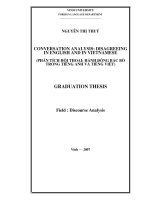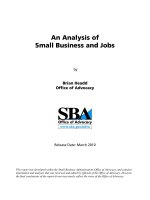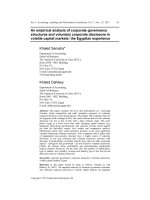KAREN MEMES AN ANALYSIS OF IDENTITY ASCRIPTION AND IDEOLOGY REPRESENTATION = PHÂN TÍCH DANH TÍNH được gán CHO KAREN và hệ tư TƯỞNG THỂ HIỆN TRONG MEMES về KAREN
Bạn đang xem bản rút gọn của tài liệu. Xem và tải ngay bản đầy đủ của tài liệu tại đây (2.62 MB, 64 trang )
VIETNAM NATIONAL UNIVERSITY, HANOI
UNIVERSITY OF LANGUAGES AND INTERNATIONAL STUDIES
FACULTY OF LINGUISTICS & CULTURES OF ENGLISH-SPEAKING
COUNTRIES
GRADUATION PAPER
KAREN MEMES: AN ANALYSIS OF IDENTITY
ASCRIPTION AND IDEOLOGY REPRESENTATION
Supervisor: Vũ Thị Hoàng Mai
Student: Nguyễn Hải Âu
Course: QH2017.F.1.E1.SPCLC
HÀ NỘI – 2021
ĐẠI HỌC QUỐC GIA HÀ NỘI
TRƯỜNG ĐẠI HỌC NGOẠI NGỮ
KHOA NGƠN NGỮ VÀ VĂN HỐ CÁC NƯỚC NĨI TIẾNG ANH
KHĨA LUẬN TỐT NGHIỆP
PHÂN TÍCH DANH TÍNH ĐƯỢC GÁN CHO KAREN
VÀ HỆ TƯ TƯỞNG THỂ HIỆN TRONG MEMES VỀ
KAREN
Giáo viên hướng dẫn: Vũ Thị Hồng Mai
Sinh viên: Nguyễn Hải Âu
Khóa: QH2017.F.1.E1.SPCLC
HÀ NỘI – 2021
ACCEPTANCE PAGE
I hereby state that I: (Nguyễn Hải Âu, QH2017.F.1.E1.SPCLC), being a candidate for the
degree of Bachelor of Arts (programme) accept the requirements of the College relating to
the retention and use of Bachelor’s Graduation Paper deposited in the library.
In terms of these conditions, I agree that the origin of my paper deposited in the library
should be accessible for the purposes of study and research, in accordance with the normal
conditions established by the librarian for the care, loan or reproduction of the paper.
Signature
Nguyễn Hải Âu
May, 4th 2021
ACKNOWLEDGMENTS
I would like to express my most sincere gratefulness to all individuals whose
contribution is an irreplaceable part of my thesis. First, I would like to send my
greatest thank to my supervisor, Mrs. Hoang Mai, who has been giving me concise
and critical comments, reminding me to overcome my procrastination and patient with
my lack of knowledge and trivial mistakes. I also would like to thank Mrs. Hanh
Hoang for providing me with valuable resources and carefully responding to my
stupid questions. Had it not been for her materials, I would not have finished even
half of this thesis. I also want to give appreciation to Ms. Thanh Ha, Ms. Quynh, and
other teachers, who have given me constructive feedbacks and great guidance. English
education is my major but choosing to conduct research on ICC issue with teachers
from ICC subdivision is definitely my right choice.
Besides, I would like to thank my classmates in 17E1, who have shared the
exhausting yet rewarding college life with me. The best thing I ever did during my
time in university is passing the fast-track program entrance test to be selected as a
17E1’s member. To be honest, most things I learned at college is from my colleagues.
My gratitude also goes to my family for helping me with housework and encouraging
me in study and life. At last, I would express thankfulness to my beloved friends, my
teammates in ETDC, AIESEC, my ex-roommates for being with me all the time,
enduring my complaints, cheering me up by all the ways they can.
My thesis could not be completed without the support from any of you.
i
ABSTRACT
Karen memes have become a trending phenomenon among English speaking
countries recently. However, there has not been many studies focusing on analyzing
how Karen’s identity is constructed in these memes. Accordingly, this research
illustrates Karen’s identity framed in Karen memes and the ideologies these memes
manifests by applying an adaptation of Shifman’s typology of memetic dimension and
drawing on framework from rhetorical criticism as well as visual rhetoric. Imagebased memes directly featuring Karen as the main character are collected on Reddit
websites, in a subreddit called r/Fuck You Karen. Text, images and context of the
memes are analyzed through critical discourse analysis. The results reveal four main
aspects of Karen namely: being an anti-masker, being anti-science, taking “I would
like to speak to your manager” as a catchphrase and being racist. There are also some
other characteristics that can be witnessed in small numbers of collected memes. Not
only do the memes have amusement purpose but they also serve as a reflection of
society and a weapon to criticize immoral behaviors.
ii
TABLE OF CONTENTS
ACKNOWLEDGMENTS .............................................................................. i
ABSTRACT ...................................................................................................ii
LIST OF FIGURES ...................................................................................... v
LIST OF TABLES ........................................................................................ v
CHAPTER ONE: INTRODUCTION .......................................................... 1
1.1. Rationale of the study ............................................................................ 1
1.2. Aims and objectives. ............................................................................. 3
1.3. Significance of the study ....................................................................... 4
1.4. Scope of the study ................................................................................. 4
1.5. Organization of the study ...................................................................... 5
CHAPTER TWO: LITERATURE REVIEW ............................................. 6
2.1. Memes and Internet memes ................................................................... 6
2.2. Karen memes ....................................................................................... 10
2.3. Ideologies and Internet memes ............................................................ 14
2.4. Semiotics and Internet memes ............................................................. 15
2.5. Theoretical framework ........................................................................ 16
Rhetorical criticism ................................................................................. 16
Internet memes and visual rhetoric .......................................................... 17
CHAPTER THREE: METHODOLOGY .................................................. 19
3.1 Data collection ..................................................................................... 19
3.2. Data analysis ....................................................................................... 20
Elaboration of Shifman’s typology of Memetic Dimension by Wiggins .. 21
CHAPTER FOUR: FINDINGS AND ANALYSIS .................................... 24
Anti maskers ........................................................................................... 24
Anti-science ............................................................................................ 28
iii
“Speak to the manager.” .......................................................................... 34
Being racist ............................................................................................. 36
Other ....................................................................................................... 40
CHAPTER FIVE: CONCLUSION ............................................................ 41
Discussion of Findings ............................................................................ 41
Implications of Findings.......................................................................... 43
Limitations and Orientations for Future Research ................................... 44
REFERENCES ............................................................................................ 45
APPENDICES ............................................................................................. 51
APPENDIX 1 ............................................................................................. 51
APPENDIX 2 ............................................................................................. 53
APPENDIX 3 ............................................................................................. 54
APPENDIX 4 ............................................................................................. 55
iv
LIST OF FIGURES
Figure
Page
Figure 2.1.1 Is this a pigeon?
7
Figure 2.1.2 The Ancient Aliens memes
8
Figure 2.1.3 The Rock driving
8
Figure 2.2.1 Joematar’s tweet on the Karen’s appearance in the
11
party
Figure 3.1. The Swole Doge and Cheems meme
21
Figure 4.1. Wearing mask is a personal choice
24
Figure 4.2. Karen with people having severe health condition
25
Figure 4.3. Karen’s grandfather’s disappointment
26
Figure 4.4. Karen can be men too
27
Figure 4.5. A Karen free country
28
Figure 4.6. The Swedish doctor
29
Figure 4.7. Tuxedo Winnie the Pooh
30
Figure 4.8. Karen lacking scientific knowledge
31
Figure 4.9. Karen as an anti vaxxer
32
Figure 4.10. Ellen DeGeneres as Karen
33
Figure 4.11. Karen being rude to the waiter
34
Figure 4.12. This is America
35
Figure 4.13. Karen as an American
36
Figure 4.14. Karen’s racism towards black people
36
Figure 4.15. Karen and affectation
37
Figure 4.16. Karen pampering her children
39
LIST OF TABLES
Table
Page
Table 4.1. Number of memes for each Karen’s identity
v
23
vi
CHAPTER ONE: INTRODUCTION
This chapter presents a brief overview of Karen memes and the rationale for
me to research this trendy meme. Moreover, it explains the aims and objectives, the
significance, and the scope of the study. The research questions are also included here.
1.1. Rationale of the study
These days, it has become common to see a funny picture, which is regarded
as meme by Internet users on social platform such as Facebook, Instagram,…The term
“meme” was introduced by Dawkins (1978) as a cultural unit spread among people.
Internet memes are described by Shifman (2014) as diffusion of items such as jokes,
videos, images, gifs, and websites via person-to-person through the Internet. Internet
memes vary in many aspects including the central character demonstrated in the
memes and people often differentiate this enormous meme pool by giving them a
name, which is normally about the meme’s main character. Karen memes are one of
them.
In the mid-summer of 2020, a famous pizza franchise in New Zealand and
Australia announced a promotion offering free pizza to women named Karen if they
could share with the company in 250 words how they were one of the "nice ones."
This pizza chain did not randomly pick this name. In recent years, Karen has become
a popular meme among English speaking countries, referring to a woman, usually
white, belonging to the middle or upper class, having negative attitudes and behaviors
from being privileged. However, a series of events happened unexpectedly in 2020
has elevated the Karen memes’ fecundity level.
In May 2020, a footage containing racist acts of a woman named Amy Cooper
was uploaded. In this video, Chris Cooper, a black birdwatcher, was going for a walk
in Central Park when he saw an insurance agent Amy Cooper with her unleashed dog.
When Chris asked this woman to leash her dog as it is the park requirements, Amy
Cooper, who is white, surprisingly reported to 911 and exaggeratedly told the
emergency that "there’s an African American man threatening my life” even though
Chris Cooper showed no sign of threats. This video immediately went viral and
1
attracted national media attention due to the dramatic scenario it depicted Black
Americans.
On the same day, after only some hours, in the other part of the United States,
a nightmare scenario was also captured on video. It was the murder of George Floyd,
a black man who was accused of stealing products from the supermarket on the street
by the white policeman publicly. That these two incidents occurred within hours of
each other served to link the racism of women like Amy Cooper to the white
supremacy that underlies police brutality. Following these events, memes in which
Karen performing ridiculous racist acts were created and spread quickly. People
joining this process may not be conscious that their acts are contributed to an identity
constitution and meditation (Ding, 2015). Internet memes are multi-function tools.
They can be used for entertainment, satire, expression, oppression, and aesthetics.
Huntington (2013) has regarded it as a form of public seduction and serves distinct
purposes with different strategies. I notice that whenever social, cultural, or political
issues occurred, there are usually a series of memes created based on them. Therefore,
investigating into how memes are used to construct the identity of a specific character
(Karen) and the ideologies incorporated in those seemingly only-for-amusement
memes might provide a better understanding of memes’ implications besides their
entertainment function.
Moreover, it is also my curiosity about the increasing popularity of Karen
memes that urged me to do this research. Surfing the Internet to explore recent trends,
fresh memes have become my daily routine for a long time. When visiting Facebook
and Reddit during the summer vacation, I noticed an increasing number of people
hash tagging Karen, posting Karen memes. Moreover, the keyword “Karen” appeared
on the comment section of several topics, including the seemingly unrelated ones
posted on 9GAG, one of the globally-most significant and social media websites.
Surprised and clueless by this prevailing trend, I did some research on Karen to gain
a basic understanding of Karen memes. The search for Karen memes results in more
than 120,000,000 results on Google, and most of them were articles, blogs, and memes
2
about Karen. The recent articles simply describe the trending of Karen memes, the
situation that people created it or made it viral. From my observation, there is a dearth
of systematic studies about the construction of Karen’s identities in the memes as well
as the ideologies in which these memes are demonstrating. Therefore, the idea of
conducting research on Karen memes and some aspects of it came to my mind.
Through this study, I hope to find out what it means to be a Karen and having “Karenish” behaviors.
The above reasons have urged me to conduct a study entitled: “Karen memes:
An analysis of identity ascription and ideologies representation.”
1.2. Aims and objectives.
These days, with the availability of the Internet, people can have access to a
great source of memes. For many people, viewing Internet memes has become a daily
routine. They look for new trendy memes, share them with friends, laugh at the memes
whose content they find especially intriguing. I also share this interest with them, and
I simply think this process is a simple act seeking entertainment. The first time the
Karen memes caught my attention was in the summer of 2020. It was when I came
across a long video clip entitled: “15 signs you are being a Karen” posted on Markian
channels. He is a famous vlogger for a series of videos portraying people in different
countries, races, classes through some stereotypical actions. Afterward, I noticed that
Karen appeared in every comment section in several other online threads. It piqued
my curiosity about Karen and its reason to become massively trendy in this
troublesome context. Therefore, this thesis is devoted to investigating how Karen
identity was framed in memes. Besides, as I mentioned above about the functions of
Internet memes, Karen memes probably have some underlying purposes, which can
be discovered by examining the ideologies that these memes embody. The objectives
mentioned can be summarized into two research questions:
1. What identities have been ascribed to "Karen" in the memes?
2. What ideologies do Karen memes embody?
3
1.3. Significance of the study
First of all, this study was conducted to identify the identities that have been
ascribed to Karen in the trending memes these days, thereby providing a detailed
insight of Karen depicting through Internet memes. Hence, the findings can draw out
some underlying themes of this meme, hopefully even the unexpected ones.
Furthermore, this study also helped to depict the memes’ ideologies presented by
people participating in the process of Karen memes transmission and diffusion.
Therefore, it can help to improve meme literacy of Internet users. Finally, I hope that
this thesis could become the theoretical basis for future scientific research in the
relevant fields, especially research on a specific meme.
1.4. Scope of the study
This research focuses on the Karen’s depiction in Karen memes and the
ideologies these memes illustrate; therefore, a digital social platform specializing in
Karen memes is my major interests; in which, Karen memes are posted, reacted,
commented, and shared by a lot of people. Among those platforms, Reddit is one of
the most typical programs for memes. According to Widman (2020), Reddit is a
website containing user-generated content—such as photos, videos, links, and textbased posts—and discussions of this content in what is essentially a bulletin board
system. It is the sixth most popular website in America. Reddit is divided into several
small communities called subreddit. Each subreddit starts with the word r/ and is
managed by moderators. Creating an account on Reddit is free. Apart from
participating in the discussions on Reddit, users can create their subreddit with their
interested topic if they meet the specific criteria. I decided to choose the biggest
subreddit about Karen memes which is r/FuckYouKaren, to be the scope of the study.
The subreddit was established in 2017 and has reached one million members recently.
Given its popularity, content, and presentation of Karen memes, subreddit
r/FuckYouKaren is the most proper scope of the study for this research. For
convenience purposes, only memes posted in 2020 will be chosen according to their
number of reactions.
4
1.5. Organization of the study
The following chapters are included correspondingly in this research paper.
Chapter 2: Literature review - provides the key term’s definition and the review
of related studies.
Chapter 3: Methodology - describes the application of a specific process to
collect and analyze data.
Chapter 4: Findings and Discussion - presents and discusses the findings.
Chapter 5: Conclusion - summarizes the findings and findings discussion,
proposes implications and limitations of the study and recommendations for further
studies.
Following these chapters are References and Appendices.
5
CHAPTER TWO: LITERATURE REVIEW
This chapter provides an adequate understanding of memes and a brief
definition of related concepts such as memes and Internet memes, semiotics, ideology.
The theoretical framework for analysis is also included in this chapter.
2.1. Memes and Internet memes
People often visit digital platforms such as Facebook, Twitter, Reddit to view
funny memes as a form of entertainment. Richard Dawkin is regarded as the creator
of the term “meme”. Dawkin (1989), with his effort to create “a name for the new
replicate, a noun that conveys the idea of the cultural transmission, or a unit of
imitation” (Dawkin, 1989, p. 182), has taken the Greek word mimeme, which means
“imitated thing”, and shortened it into “meme” with a view to capturing the link
between culture and memory. While coining the term “meme”, Dawkins has
connected its imitation and evolution to its biological counterpart:
as genes propagate themselves in the gene pool by leaping from body to body
via sperms or eggs, so memes propagate themselves in the meme pool by
leaping from brain to brain via a process which, in the broad sense, can be
called imitation.
(Dawkins, 1989, p. 192).
Memes that spread from person to person can be broken down into small
components such as catchy lines, gestures, images or ideas. For example, the saying
“No matter how good you are, there is always an Asian better than you” has been a
popular memetic material for commenting on posts or news about Asians. Dawkins
(1989) has stated that not every gene can replicate successfully, and the same scenario
happens to memes. For a meme to be successful, he suggested, it has to fulfill three
prerequisites: copy-fidelity (referring to qualities that enable reproduction), fecundity
(referring to the meme’s ability to spread); longevity (referring to the time’s length).
Internet meme is “a remixed, iterated message that can be rapidly diffused by
members of participatory digital culture for the purpose of satire, parody, critique, or
other discursive activity.” (Wiggins, 2019, p. 11). Some differences between Internet
6
memes and its counterpart were also listed in Wiggin’s work. Firstly, the original
concepts of memes are culturally based. Everything that it enables and all that enables
it except for the biological is a meme. For example, how “kiss” is negotiated in
different cultures is a meme. It is polite for a male person to kiss on the hand of a
female person as a greeting practice in some European countries. Still, similar action
practiced in other cultures could be misrepresented or even criticized for having
sexual harassment behavior. However, the kiss remains recognizable and
knowledgeable. People still view it as a cultural practice that expresses feelings and
relationships between people (Wiggins, 2019). Secondly, meme does not require
electronic devices or digital platforms to be used, nor does it inquire about language
mutual intelligibility. In contrast, similarities between Dawkinsian memes and
internet memes are that both require attention and must be reproducible (Wiggins,
2019).
Milner (2012) has separated Internet memes into two significant categories
namely remixed images and stable images. The former involves altering public
artifacts and practice to an image, while the latter one pertains to the authentic images
transmitting among recreating participants. The remixed images themselves can be
divided into two subcategories which are single images and stacked images. As its
name, single images are remixed images created within a single panel only. For
instance, the butterfly meme (“Is this a pigeon?) is a single image
Figure 2.1.1 Is this a pigeon?
Besides, image macros, photoshops, and quotes are also single images.
Among those which have been mentioned, image macros seem to be the most popular
7
ones. Simply put, an image macro is a picture or an artwork with text. One outstanding
example of image macros that can be mentioned is the Ancient Aliens memes
Figure 2.1.2 The Ancient Aliens memes
In contrast, stacked images are the combination of new mixed photos.
Examples of stacked images that can be listed are “Rage comics”, “Finding Neverland
memes”, “The Rock driving”, ...
Figure 2.1.3 The Rock driving
The development of Internet culture, as it was noticed by Brown (2014) attracts
more and more people to social media to express themselves, leading to the increasing
8
popularity of Internet memes. Internet memes viewing and exploring become their
daily routine. They post, react, share with their friends, and laugh at memes they find
amusing. He described it as a cultural process as the traditional memes. Memes are
featured on many social networks such as Facebook, Twitter, and Tumblr to view,
react and share. They can also create their own memes, post, and reference them
effortlessly. Marwick (2013) has identified the way an Internet meme influences is
based on its transmission online and this idea was agreed by Shifman (2013). He also
added that although the content Internet memes include passes along from person to
person, it constantly escalates to a shared social phenomenon. Consequently, Internet
memes can be considered as a microlevel discourse to analyze and understand the
macro-level discourses (Huntington, 2013; Knobel & Lankshear, 2007; Mina, 2012;
Shifman, 2013). The concept of exchanging ideas through the public sphere was
thought to begin in the 1960s by Ding (2015). He pointed out the function of Internet
memes as discursive practices for people to interact through a public sphere provided
by the Internet. They can create, react, share and retransmit those messages. At the
end of the 20th century, the Internet has risen to popularity, took traditional social
spaces, and became the latest English platform (Vlavo, 2012). Thus, the transmission
of memes became highly visible (Shifman, 2013). There are many websites, such as
Meme Generator, Quick Meme, which enable people to design their own memes
without having complicated technological or design skills. Low requirements for
inclusion are part of a participatory culture (Jenkins, 2009). It is the participation that
turns Internet memes meaningful collectively (Brown, 2014). As a result, people’s
viewpoints have an impact on forming individual self-perspectives. With participatory
culture, people can raise their voices, challenge deep-rooted prejudice and infringe
boundaries.
9
2.2. Karen memes
The "Karen" meme itself has multiple origins. According to Know Your Meme
(2018), at least three theories about the origin of this meme can be traced. The first
theory is that Karen began being used as a derogatory name because of a character
named Karen in the movie Mean Girls, a teen comedy film released in 2004. In this
movie, Karen Smith once questioned a girl “So if you’re from Africa, why are you
white?”, then immediately received an admonishment from her friend “Oh my God,
Karen, you can't just ask someone why they're white” (Know Your Meme, 2012). This
line quickly became viral and has been remixed as memes over the years (Greenspan,
2020). On the other hand, other people believe that Karen has been used since 1989,
which was quite earlier than previously thought based on the appearance of the
character Karen in Goodfellas, a gangster film released in the same year. The third
theory is that the meme has its credit belonging to an American comedian named Dane
Cook. It was mentioned in his standup comedy routine called "The Friend That
Nobody Likes", included in the album Retaliation, released on July 26th, 2005. Cooks
shared with people about his group of friends in the routine, whom he regarded as
having known the longest in his life. He pointed out that in every group of friends,
there was always an outcast that nobody liked. The only purpose of them in the group
was to be the person that everybody detested and talked negatively about when they
were not around. He used Karen as an example of this person, using the word
"douchebag" to describe her.
One of the first cases of Karen memes spreading widely was on October 20th,
2016, when Nintendo released their first trailer for the Nintendo Switch. The video
was a seemingly ordinary promotion trailer for the company's products, with
characters in the video enjoying the video game console in many places, including
homes, train stations, and airplanes. However, there was one detail that was worth
noticing. It was a short-haired white woman bringing the Nintendo console to a
rooftop party. Immediately, Tumblr user Joematar posted a joke about this woman
with the caption, "Oh shit, Karen brought her stupid Nintendo thing to the party again.
10
We're DRINKING, Karen. We're having CONVERSATIONS." (See Appendix 2)
Until December 27th, 2017, the post has over 23,000 notes (Know Your Meme, 2017).
Figure 2.2.1 Joematar’s tweet on the Karen’s appearance in the party
In November 2019, footage of a woman aggressively stopping a car on the
road, accusing the driver and the passenger inside of almost hitting her kids with
insulting words, has become viral on the Internet. When the passenger advised the
unknown woman to be careful with her words since the children could hear them, the
woman confidently dismissed this as her children were listening to Kidz Bop (a
children's song). After being posted on Youtube, the video has become massively viral
and had 16 million views. That was how "Kidz Bop Karen" was created. Another
hashtag becoming trendy during this time was #AndThenKarenSnapped. According
to Know Your Meme (2018), the first Twitter account using this hashtag is
@RiotGrlErin. On January 20th, 2020, she tweeted the hashtag after saying, "The
Apps were cold". Promptly, Twitter users began using the hashtag to tweet comedic
scenarios in which the Karen character would get frustrated. Twitter user
@MunaNawabit1[6] tweeted, "Found out that the study they funded to prove vaccines
because autism proved that vaccines don't cause autism #AndThenKarenSnapped"
and garnered over 9,300 likes and 2,300 retweets in a day.
11
With the rapid development of technology, handy devices for filming and
recording have become increasingly popular in recent years. Therefore, it is effortless
for all kinds of incidents to be captured, posted, and shared on the Internet without
permission at an incredible speed. Once those videos become viral, online people
would ascribe a familiar name to the committer that fitted the situation (Nagesh,
2020). Before Karen, there were some other names such as Becky, Chad, or Tammy.
Some of these commonplace names' origins can be pinned down. "Permit Patty" was
born after the incident of a woman complaining towards a water-seller. Similarly,
another woman who dialed the police to report a black family having a barbecue was
dubbed "BBQ Becky". Another white woman who called 911 on a black dad at a
football match while sitting in a golf cart was called "Golf Cart Gail".
The popularity of Karen is also attributed to Reddit. Specifically, Reddit is a
prominent social platform consisting of several forums in which registered users can
participate in the discussions of every topic they are interested. Due to its massive
scale, Reddit is divided into many subreddits referring to a specific topic. In December
2017, r/FuckYouKaren, the largest subreddit about Karen was created, and by the end
of October 2020, it had reached one million members. Tiffany (2020) claimed that
this creation was in honor of a Reddit member who had gained brief fame after sharing
complaints resentfully about his malicious ex-wife. The subreddit now has turned into
a place for posting all memes that revolve around which they regard as "Karen" -ish
behaviors.
After the Central Park accident and the death of George Floyd, Karen memes
became more popular. Besides, the outbreak of Coronavirus also plays an essential
part of this meme’s popularity. The name Karen has also been used for a lot of people
having bad behaviors and attitudes during the pandemic. When the number of infected
cases and deaths escalate dramatically in America, covering faces with masks
becomes compulsory, and any individual attempting to violate this rule will be heavily
charged. People who refuse to wear masks in public places, people who share
unconfirmed information and conspiracy theories about the virus on the Internet, or
12
people who believe the virus is merely a joke are all regarded as having “Karen’s
behavior” (Nagesh, 2020).
As I have stated above, there has not been much research examining a
particular meme, and for Karen memes, this number is even inconsiderable. Ding
(2015) presented a study about Asian memes, which also drew the concepts from
visual rhetoric and rhetorical criticism as two of his theoretical frameworks, to
examine how people use memes as a tool for ethnic identities negotiating and
investigate Internet memes as persuasive discourse. His findings mainly discussed
how Asian people were depicted in dominant discourse and how they presented
themselves in memes and how memes became a weapon to challenge racism and
oppression. However, Karen memes are not particularly illustrated a group of people
sharing the same appearance, origin and some social patterns as Asian community
does. Though Karen is normally white, female and middle-aged, the participants of
r/Fuck You Karen have never provided any stereotypes of this character. For those
who participate, everyone can be Karen.
Other studies about meme such as “cash me ousside” meme, the “when” meme,
“lolcat” meme focused on the linguistic aspects of these memes. Presented by
Vásquez and Aslan (2021), the “cash me ousside” discussed the virality of the
catchphrase “Catch me outside, how about you” which is taken from a series. The
pronunciation and the face expression of the character made the meme popular. Karen
memes also have catchphrase, but it only reflects an aspect of Karen and research is
needed. The “when” meme discussed multimodal simile generated by linking verbal
and visual elements since all “when” memes follow the same caption structure (Lou,
2017). Lastly, LOLcat meme revealed findings about English syntax used in memes
and the effects of this syntax (Laksonso and Putranti, 2016)
13
2.3. Ideologies and Internet memes
The term “ideology” itself can be defined in different ways. Storey (2006)
described “ideology” as “a systematic body of ideas articulated by a particular group
of people”. In this definition, the collection of ideas was viewed as a systematic body,
and articulation is the action initiated by people participating in the group. Another
definition of ideology concerns the concealment of reality in “such a way that what
the average working person sees is merely presented as a version of reality, and one
that solely serves the needs and requirements of dominant, powerful elites” (Wiggins,
2019, p.26). This definition showed a social reality where the dominant group does
not see themselves as the autocrats; they simply enjoy their lives even though they
benefit from the masking of the true nature of reality. Wiggins has summarized this
ideology’s definition by a phrase “they do not know what they are doing, but they do
it anyway” (p. 26) since he noticed the purpose of the individual following orders is
to obtain and spend material possessions and to view themselves living the lives, they
wish instead of being dominated. Besty and Annabelle (2019) provided a more
straightforward definition of ideology. They stated that ideology is a set of beliefs, a
world view, and literally, every person has ideologies even though it may seem natural
and ordinary. Moreover, ideology is constituted by the assumptions that can be
identified. For example, people supposed to be a Karen is terrible, and that the rule of
r/FuckYouKaren is Do not be a Karen.
Regarding internet memes, another definition of ideology was introduced by a
French philosopher, Roland Barthes. He paralleled the term “myth” with ideology,
given his stress on the connotative power of the relationship between text and image.
He wrote that
[m]yth does not deny things; on the contrary, its function is to talk about them;
simply, it purifies them, it makes them innocent, it gives them a clarity which
is not that of an explanation but that of a statement of fact.
(Barthes, 1977, p. 301)
14
In this statement, Barthes clarified the ways myth is used to talk about
something. It depicted the desired details, excluded something negatively affecting
the argument, and regarded it as a fact (Wiggins, 2019). The fifth definition of
ideology mentioned in this thesis came from Althusser. He explained ideology as a
collection of beliefs and practices used to maintain the connection between an
individual to the world and vice versa (Althusser, 2006). In this relationship, a person
expresses themselves following a specific worldview depicting how complicated it
may be. Later, this expression is tied to actions that are decided by sets of beliefs and
values connecting people to the world. Internet memes can be linked to ideological
practice. By creating memes to refer to something, interpreting and comprehending,
people have participated in the process of ideological formation, revealing an
ideological approach.
2.4. Semiotics and Internet memes
Semiotics is the study of the way “signs” convey meaning. It focuses on the
communication’s symbolic nature as when communication is established, sounds or
pictures are constructed to represent ideas (Baldwin, Coleman, Gonzalez and
Suchitra, 2014). According to Umberto Eco (1976), semiotics is “the discipline
studying everything that can be used in order to lie” (p.7). There are many nonverbal
aspects of signs that can be observed, such as: make-up, tattoo, toupee, clothes, and
so on. These facets represent some image or identity that can be true or not (Berger,
2005). If we take the “Slightly Smiling Face” Facebook icon, for example, it is
observable that it “signifies” something. Some people think it means the users are
happily friendly or show a positive attitude, or some might think by using this icon,
the users indicate a helpless feeling, which means:” Yes, I am done”. Others might
find this icon carries a negative attitude such as wrath or disdain. According to Fiske
(1990), the object or idea it represents is the signified, and the sound or image
represents it is the signifier. By combining these two key terms and acknowledging
the relationship between them, we have the term “sign” (Barthes, 1968).
15
Ideas can be represented by many sounds and images which are borrowed from
a collection of relevant sounds or images signifying the idea (Baldwin, Coleman,
Gonzalez and Suchitra, 2014). The act of putting signs together to create ideas
becomes a rich field of semiotic meaning. For some cultures, having a similar value
does not mean sharing the exact relationship between signifier and signified. For
example, by showing table etiquette, in one culture, making noise when eating is
necessary, but in another culture, eating in silence is appreciated. Leeds-Hurwitz
(1993) proposes that semiotics can be used to perceive culture myth, artifact, and
behavior, besides nonverbal behavior. Wiggins (2019) suggests that Internet memes
incorporate a semiotic meaning that is fastened to an ideological practice. He also
suggests that semiotics and ideology should be viewed as reciprocal to each other.
Hodge (2017) states that ideology is an essential concept to “socially oriented
semiotics because it identifies a unitary object that incorporates complex sets of
meanings with the social agents and processes that produced them”. Based on the
work of Voloshinov, his work indicates that the defining aspect of all ideological
systems depends on signs and symbols to convey meaning. As ideology is utilized to
bind behavior, lead it in ways that dominant groups prefer when people act according
to beliefs that match their worldview and have a conscious disagreement with another
worldview, this is accomplished (Wiggins, 2019). Their actions might be using codes
or rules and symbols for communicating. To put differently, by showing verbal or
nonverbal expression, people choose specific semiotics to agree or disagree with the
internet meme’s message. For example, ideological practice is provoked by showing
reactions, sharing, or commenting on the meme.
2.5. Theoretical framework
Rhetorical criticism
According to Foss (2008), rhetorical criticism is a qualitative research method
which is “designed for the systematic investigation and explanation of symbolic acts
and artifacts for the purpose of understanding rhetorical processes”. In this research,
selected Karen memes are rhetorical artifacts. Due to its high speed of circulation and
16









